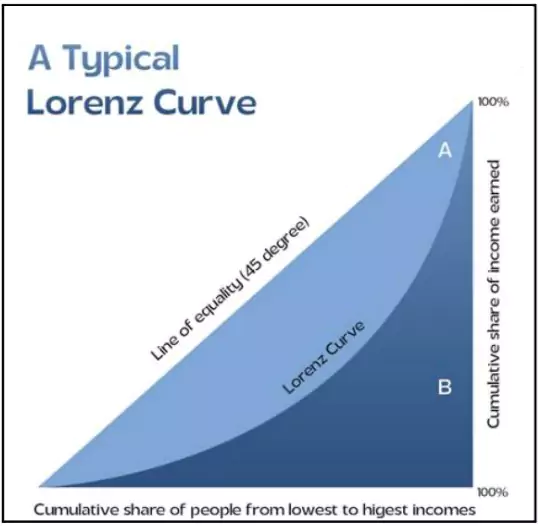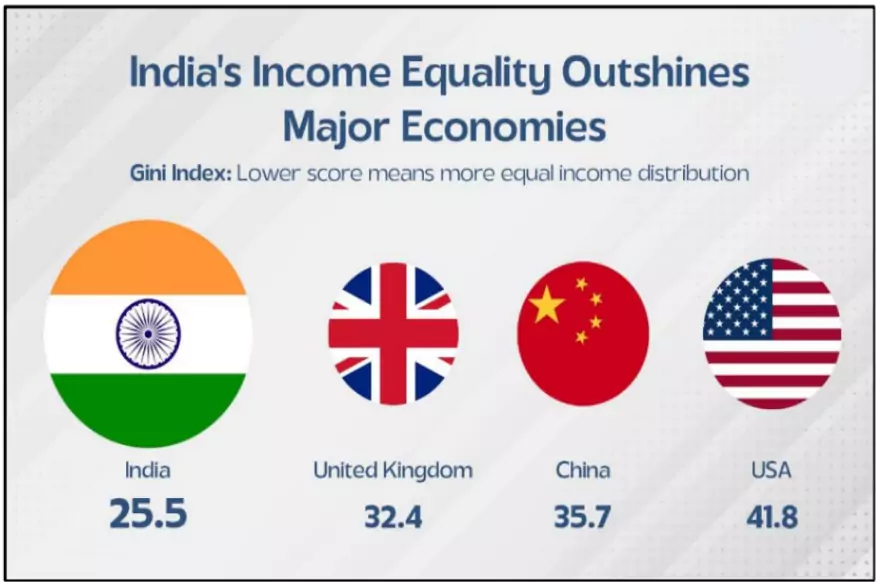According to the World Bank, India’s Gini Index stands at 25.5, making it the fourth most equal country in the world, after the Slovak Republic, Slovenia and Belarus.
Gini Index

- The Gini Index measures how much the distribution of income or consumption deviates from perfect equality
- The Gini index, or Gini coefficient, was developed in 1912 by Italian statistician Corrado Gini.
- It measures how income, wealth, or consumption is distributed among individuals or households in a country. It reflects the degree of inequality, not the absolute levels of income or wealth.
- It ranges from 0 to 100:
- 0 = perfect equality (everyone has the same income)
- 100 = absolute inequality (one person has everything, others have nothing)
- The higher the Gini Index, the more unequal a country is.
- The Gini Index is often illustrated using the Lorenz Curve:
- The diagonal line represents perfect equality.
- The Lorenz Curve shows actual income distribution.
- The Gini Index measures the gap between the two curves as a percentage of the total area under the diagonal.
- A larger gap between the Lorenz curve and the line of equality means greater inequality.
Key Highlights from the Gini Index 2025 Report

- India ranks 4th globally on the Gini Index with a score of 25.5, behind only the Slovak Republic (24.1), Slovenia (24.3), and Belarus (24.4).
- India is more equal than all G7 and G20 countries, including China (35.7), USA (41.8), and the UK (34.4).
- The term “most equal country” describes a nation where income and consumption are distributed more evenly among its population
- Out of 167 countries assessed, India falls into the “moderately low” inequality category — and is very close to the “low inequality” group.
- Globally, just 30 countries fall into the “moderately low” inequality category, including several European countries with strong welfare systems.
- This is a significant achievement for a country of India’s size and diversity, reflecting policies focused on reducing inequality and poverty.
- India lifted 171 million people out of extreme poverty.
- The share of the population living on less than $2.15/day dropped from 16.2% in 2011–12 to just 2.3% in 2022–23.
Reasons behind it
India’s progress towards greater income equality is backed by a series of focused government initiatives.
- PM Jan Dhan Yojana: Financial inclusion has been at the heart of India’s social equity push. As of June 25, 2025 over 55.69 crore people hold Jan Dhan accounts, giving them direct access to government benefits and formal banking services.
- Aadhaar and Digital Identity: Aadhaar has enabled the creation of a unique digital identity for
- residents across the country.
- Direct Benefit Transfer (DBT): The DBT system has streamlined welfare payments, reducing leakages and delays. Cumulative savings have reached ₹3.48 lakh crore as of March 2023, reflecting its efficiency and scale.
- Ayushman Bharat: Access to quality healthcare is key to improving social equity. The Ayushman Bharat scheme provides health coverage of up to ₹5 lakh per family per year.
- PM Vishwakarma Yojana: Traditional artisans and craftspeople are vital to India’s economic and cultural fabric.
![]() 8 Jul 2025
8 Jul 2025



